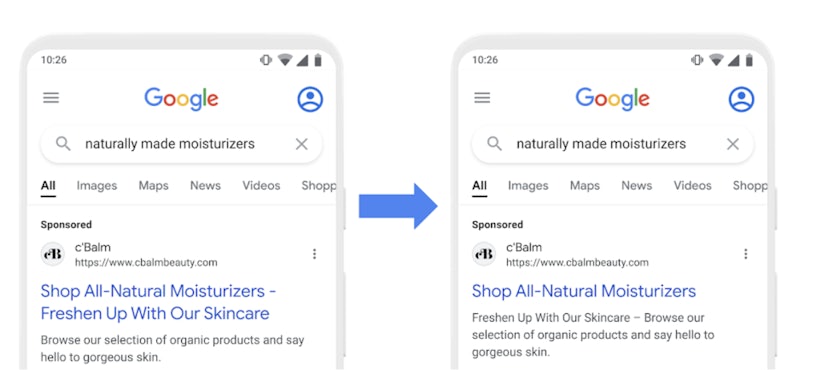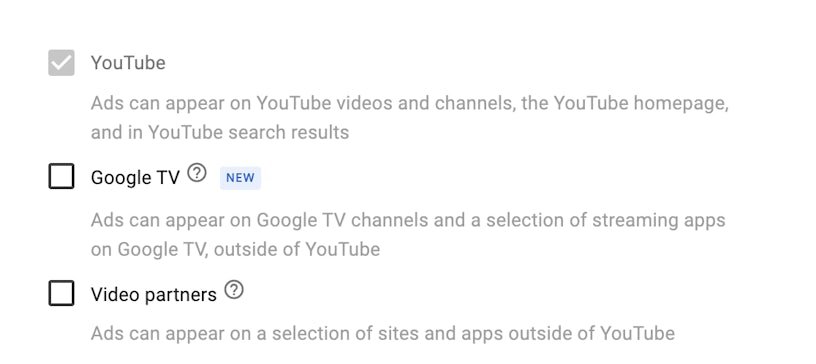Welcome to the latest blog from Impression on Paid Media Industry Updates, where we uncover the latest paid media trends to help you stay ahead of the curve.
Dust off the January Blues as February is well underway. 2024 has already seen various changes and announcements to the paid media landscape for the upcoming year and advertisers, more than ever, must ensure that their strategy is reflecting the new requirements being pushed out.
- Everything Paid Media - Top takeaways
- Google is rolling out changes to the way Search Ads work with assets
- Google announces updates to its Performance Max campaigns
- Asset generation
- Imagen 2
- Ad strength
- Google announces changes in bidding strategies for Hotel Ads
- Google introduces an update in its Misrepresentation policy
- LinkedIn is simplifying action tracking with a new feature called Website Actions
- Serve YouTube ads on Google TV, independent of YouTube Partners, with the latest Display & Video 360 update
Everything Paid Media – Top takeaways
In this blog, we’ll transverse through some of the major changes that have happened in February so far in paid media, whether that be platform changes, tech updates or new product launches.
Our top takeaways are:
- Google rolls out a raft of updates to Pmax allowing users to generate images and assets with AI-powered technology
- On Social, one for our business marketers, LinkedIn has introduced a new way to measure activity in a post-cookie world
- Advertisers can now serve YouTube ads on Google TV, independent of YouTube Partners
Google is rolling out changes to the way Search Ads work with assets

Earlier this month, Google introduced new changes to the way its search ads work with assets.
As part of this, Google revealed improvements to how its search ads would be displayed via the search page results, opting for a more cleaner, tidier look, predicted to improve performance and drive better results.
Previous to this, Google AI would assemble ads by including a minimum of two headlines within its text, identifying the best combination of headlines and descriptions to help advertisers deliver the best possible ad, to the right person at the right time.
However, it was found in some instances that depending on the context and query of the user’s search, showing 1 headline can help deliver better performance, than the use of two standard headlines, typically found on most search ads.
Based on this, Google will now be letting search ads show one headline when its predicted to improve performance – with the second headline now being eligible to show at the beginning of description lines (see screenshot below)

Whilst, any pinned assets to headline position 1, headline position 2, or description 1, will continue to show in their designated positions when ads are served.
Parallel to this, Google will also be rolling out campaign-level headlines and descriptions, meaning advertisers will now be able to have the option to associate up to three headlines and two descriptions at campaign level. If these assets need to be shown during a specific period, such as a sale, advertisers will now be able to schedule specific start and end dates for them, whilst also having the ability to pin these to specific positions – making them eligible to show in every responsive search ad within campaigns.
Another change that Google have announced is the way automated assets will be shown compared to its manual counterpart. This means that any dynamically-created assets such as sitelinks, callouts, and structured snippets will now be eligible to show alongside, or in place of, manually created assets of the same type. For example, if an ad had four manually created sitelinks available, rather than Google serving this in place of their automatic equivalent like it would usually do, Google AI would now instead show two dynamic sitelinks in conjunction with the two manually created sitelinks if it’s predicted to improve performance.
What does this mean for me?
According to Google, these new changes will help advertisers improve the performance of their ads, whilst also making it easier for advertisers to make any changes quickly and seamlessly if need be.
However, at the same time sparks controversy, providing advertisers with less and less control over which headlines and descriptions will be shown. This may become problematic, particularly for clients who may be concerned about exactly what copy is being shown to users, and therefore may be reluctant to test activity going forward.
However, Google does signpost advertisers to review the ‘combinations report’, to gain insight on how often ads are shown with one headline or a headline at the beginning of description lines, to see which assets are more effective at driving performance.
Though equally, it can be argued that this will make ads more relevant to users, as context will be tailored to users’ queries, increasing engagement and therefore performance.
Google announces updates to its Performance Max campaigns

This month, Google announced several updates to its performance max campaigns, rolling out an array of AI tools designed to enhance the quality of ad creatives and improve the optimisation of its ad campaigns.
As part of these updates, Google has announced the following:
Asset generation
Initially, introduced in November 2023, asset generation is now set to expand globally in English, with more languages set to follow. Through leveraging Google AI model capabilities – Gemini, PMax will now be able to include longer headlines, making it easier to create text and image assets for campaigns – with sitelink generation set to be rolled out soon.
Imagen 2
Following this, Google will also be updating its generation model to Imagen 2. This will allow advertisers to create lifestyle imagery within their PMax campaign and enable advertisers to make variations to their existing top-performing images, allowing them to scale their creative even further.
Ad strength
Ad strength is also changing the way it calculates its ad strength score for PMax campaigns. This will mean Google will now place greater emphasis on the quantity and variety of ad assets an asset group contains within a PMax campaign.
To help advertisers optimise their asset mix, Google has suggested the following:
- Add more assets – including AI-generated adaptations of existing creatives
- Leveraging design platforms, such as the likes of Canva that allow you to import images directly into campaigns
- Incorporating video, as Google says containing at least 1 video creative can substantially boost conversions significantly
What does this mean for me?
For advertisers, these new updates will enable marketers to take advantage of AI capabilities, to create better quality creatives for their campaigns, ultimately allowing them to optimise campaigns more effectively to drive performance.
Additionally, Google enhancing its Ad Strength indicator will give advertisers more information about their ad assets, allowing them to better evaluate their asset quality and variety.
Pallavi Naresh, a Group Product Manager from Google highlights that using a wide variety of creative, does improve performance – “Great creative drives results”, finding that “those advertisers who improve their Performance Max ad strength to ‘Excellent’ see 6% more conversions on average”.
Google announces changes in bidding strategies for Hotel Ads

Google has revealed forthcoming adjustments to its Hotel Ads, marking a response to the ongoing recovery of the travel industry following the challenges posed by the COVID-19 pandemic.
As the hospitality and tourism sectors worldwide undergo a revival, Google plans to retire old commission-based bid strategies, such as Commissions (per Stay & per Conversions) for Hotel Ads, and substitute them with a more contemporary, automated, and widely recognised bid strategy – target ROAS (Return on Ad Spend).
The Commissions (per Stay) bid strategy has already stopped accepting new allowlist requests and both commission-based bid strategies will no longer be available on the platform by the end of April 2024. Campaigns utilising active commission-based bidding strategies will persist in operation until the sunset date, and advertisers will have time until October 31, 2024, before Google completely deactivate both bid strategies.
Google also announced expanding Performance Max campaigns by adding new travel-related campaign goals, which will support using Google’s artificial intelligence to enhance budget efficiency by optimising bids based on campaign performance goals.
What does this mean for me?
Both commissions-based bid strategies heavily depended on the use of third-party cookies for precise tracking of visitors’ stays and calculating commission payouts. Consequently, given Google’s plans to completely phase out the use of third-party cookies for all users starting Q3 2024, the advertising platform required a more robust and lasting solution to assist advertisers in the hospitality industry.
Finally, digital marketers who are using hotel ads received a proven and efficient tool in the form of the target ROAS bid strategy that utilises Google’s AI to improve bid optimisation using real-time signals.
In conclusion, digital marketers utilising hotel ads now have a verified and effective tool in the shape of the target ROAS bid strategy, which employs Google’s AI to enhance bid optimisation through real-time signals and can use new travel-focused campaign goals in Performance Max campaigns.
Google introduces an update in its Misrepresentation policy

Google regularly introduces updates to its advertising policies to ensure that users from all around the world can trust the ads appearing in their search results when browsing the Internet using Google’s products. The main reason for these changes is to guarantee that the ads show clear and honest information, so users can make informed decisions.
That is why the advertising platform does not allow advertisers to run ads and destinations that mislead users by concealing or providing misleading important information about businesses, products or services.
Google plans to add a new unacceptable business practice to its Misrepresentation policy: “Enticing users to part with money or information by impersonating or falsely implying affiliation with or endorsement by a public figure, brand, or organization.”
The policy update will begin to take effect in March 2024 for all advertisers outside of France, and a month later, it will also apply to advertisers in France.
What does this mean for me?
The giant from California announced its intention to treat violations of the new policy very severely. Accounts found to be in breach of the new policy will be suspended without prior warning and will not be allowed to advertise on the Google Ads platform again.
Hence, it is crucial for advertisers outside of France to review their ads in the accounts and take necessary actions before March 2024. This is to ensure that their ads comply with the new standards of acceptable business practices and avoid the suspension of the advertising account.
LinkedIn is simplifying action tracking with a new feature called Website Actions

LinkedIn has officially introduced its measurement tool named Website Actions.
Website Actions enables marketers to manage their measurement and retargeting efforts, providing a seamless and easy approach for marketers to identify optimisation opportunities.
With Website Actions, marketers can set up new conversions and build retargeting audiences without requiring additional setup or code. Using the Insight Tag, Website Actions automatically collects and tags all the actions potential buyers perform on your website.
What does this mean for me?
As third-party cookies are deprecated, marketers face challenges in tracking and understanding user behaviour. While Google Analytics Goals has been relied upon, there’s a rising demand for integrated, privacy-compliant solutions. LinkedIn’s Website Actions fill this gap, providing a more tailored approach, especially beneficial for businesses heavily invested in LinkedIn marketing.
At its core, Website Actions provides a nuanced approach to tracking every significant interaction of visitors on your website, guaranteeing you the insights necessary for informed decision-making on your LinkedIn Ads investment. This means:
- Enhanced retargeting capabilities: Utilise visitors’ behaviour data to craft highly targeted campaigns based on call-to-action buttons and page views for improved ad effectiveness.
- Improved reporting: Access precise data to accurately measure your campaigns’ impact.
- Improved optimisation opportunities: Utilise more precise and detailed data to make better decisions, optimising performance and allocating your budget more effectively based on valuable actions.
Serve YouTube ads on Google TV, independent of YouTube Partners, with the latest Display & Video 360 update

Google TV is a streaming platform where users can stream their favourite TV shows, movies, and other video content. As of 2024, there are 220 million monthly active Google TV devices, up 46% YoY. This correlates with the broader trend in Connected TV (CTV) uptake, which is forecasted to grow +12.1% in 2024, bringing with it a total of $33bn in global ad spend.
Until January, advertisers have been able to target Google TV inventory through the Video Partners inventory source within their YouTube campaigns. The recent update has split Google TV targeting out from the rest of the YouTube partners’ inventory, giving advertisers greater control over where their ads serve and if they appear specifically on Google TV, to better align their video campaigns with the forecasted rise in CTV.
As of January 11, 2024, the Google TV inventory source was available and enabled by default across non-skippable line items on DV360 as well as any instant reserve deals that use bumper, masthead and non-skippable in-stream ads.
What does this mean for me?
This means that you will now have the option to opt in or out of appearing on Google TV independent of appearing on other YouTube partners, by deselecting the Google TV inventory source targeting at line item level. This will provide you with greater autonomy over where your ads serve and whether or not you want to utilise the Google TV inventory available on DV360 in your campaigns, separate from the Video partners targeting option.

It is worth noting that, in January, any existing and eligible line items on DV360 that were already enabled to serve on Google video partners were auto-enabled to serve on Google TV. So you will need to check your line items and deselect Google TV if you don’t want your ads to be seen on their platform.
Look out for our next blog in February for more paid media industry updates to inspire your paid media strategy. If you want to talk about your business aspirations, get in touch!



